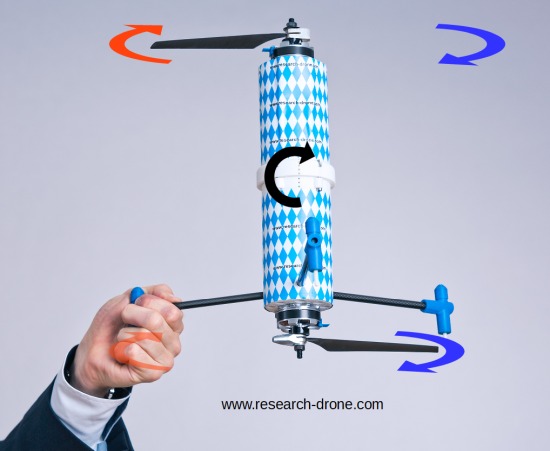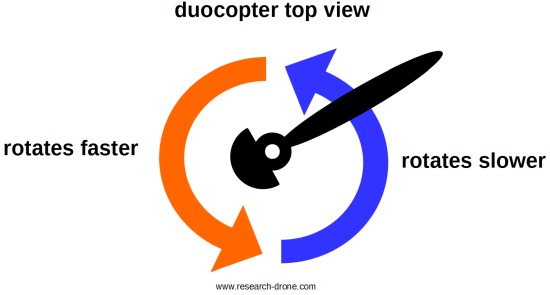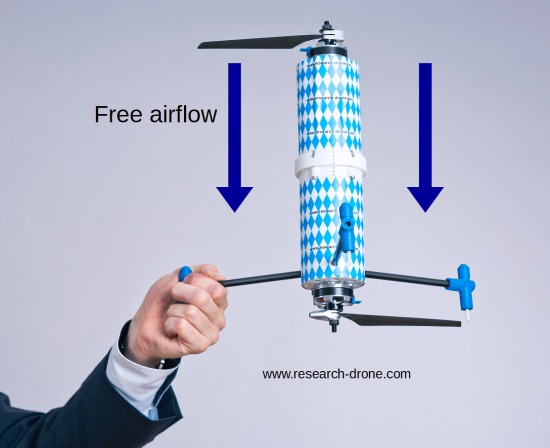DuoCopter drone with two motors
Imagine a drone needed only two motors, no more. This is the DuoCopter. This drone requires only two motors and is controllable like a normal quadcopter. This is made possible by a newly developed and highly innovative algorithm and with standard components. This technology is patent-protected.
picture: Dirk Brunner; license: CC BY SA 3.0
How the DuoCopter works
Each of the two engines has a simple single blade propeller. The faster the propeller turns, the more thrust is generated - this is easy. The innovative algorithm is capable of influencing the speed per revolution. If on the left side of the model more thrust should be generated than on the right side, the propeller rotates faster (red arrow in the image) left than right (blue arrow in the image).
picture: Dirk Brunner; license: CC BY SA 3.0

picture: Dirk Brunner; license: CC BY SA 3.0
As more thrust is generated on the left side of the drone, the drone turns to the right (black arrow in the image). The innovative algorithm implements the requirements of the flight control and / or remote control and controls the propeller according to this principle. This sounds very simple in theory. To put this principle into practice, many conditions must be fulfilled. For example, the algorithm must work in real-time on a normal motor controller and operate reliably. All of this is associated with a lot of research and development work.
Advantages of the DuoCopter
Compared to a quadcopter, hexacopter or octocopter, there are numerous advantages (only the quadcopter is mentioned in the following):Higher efficiency
By means of a further developed motor controller, the battery can be charged efficiently with the brake energy. This works with high efficiency as with a flywheel. For acceleration, energy is removed from the battery.The design of the DuoCopter prevents obstacles in the area of high propeller airflow.

picture: Dirk Brunner; license: CC BY SA 3.0
Think of the traditional construction.

picture: Dirk Brunner; license: CC BY SA 3.0

Foto: Dirk Brunner; license: CC BY SA 3.0
The overall engine power of the DuoCopters is similar to conventional models. A larger engine operates more efficiently than several small engines. Here too there are potential savings.
Less components
Only two motors are needed. Not more. This eliminates a large part of the conventional mechanical design. The cabling is greatly reduced, because the motors are much closer to the battery. And the fact that only two motors needed to be connected simplifies the setup.Quieter
The DuoCopter is quieter than a model with 4 or more engines. This is due to the unblocked air flow and also because of the lower propeller speed. With the same size, the DuoCopter can use larger propellers. These turn slower and are quieter.Robust
The compact design makes the DuoCopter more robust than conventional designs. If a normal quadrocopter crashes sideways, the landing gear and at least one arm including the motor may be defect. With the Duocopter only the landing gear and possibly the propeller is affected.
Foto: Dirk Brunner; Lizenz: CC BY SA 3.0
The hull protects the engine from damage.
Smaller silhouette
The body of the DuoCopter is smaller than that of a comparable quadcopter. This makes the silhouette smaller and the model is not spotted so quickly by other people.Inexpensive
Since fewer components are required, the body is smaller and fewer cables are required. The manufacturing process is more favorable.No propellers in the picture
The innovative algorithm knows exactly where the stiff propeller is at any time. Even if a camera looks exactly through the propeller circuit, the propeller is not visible in the picture. The algorithm can provide a signal when the view is clear and thus trigger the camera when no propeller is in the picture. This allows the camera to be installed in the body and does not have to be installed below the model. With this conventional design the camera is at risk with harder landings, with the DuoCopter not.Long flight range
The DuoCopter allows for longer flight ranges than conventional designs. The DuoCopter's fuselage does not produce any downforce during fast flights, as is the case with normal quadcopters. These models are rather flat. If these are tilted forwards in order to enter the forward flight the flat structure produces downforce.
picture: Dirk Brunner; license: CC BY SA 3.0
Think of a hand that will keep you out of the car. If the hand is tilted forwards, it is pressed downwards by the airstream. The motors of a quadcopter have to handle this, which costs additional energy. Now make a fist with your hand similar to the DuoCopter's body and tilt your fist forward. No downforce is noticeable. The design of the DuoCopter thus saves further energy.
Less area exposed to wind
When a quadcopter is flown in the wind, the control algorithm has more to do, since the model is wind-prone. Think of the flat construction. The part of the drone facing the wind shadows the rear part slightly. This results in an unequal force effect on the drone. The wind can tilt the model more. With the DuoCopter, this risk is significantly minimized. The cylindrical hull provides the wind with little attack area and the model is more stable in the air. As a result, the control system has to intervene less, which saves additional energy.Positioning of the propeller
Since the algorithm knows the propeller position accurately, it is possible to stop the propeller in a certain position.Easy transport and smaller pack size
The conventional outriggers and large hull construction are no longer necessary at the DuoCopter. The DuoCopter is easy to transport. Even a handbag is enough, where a transport case is necessary for comparable models.Scalable
The technology of the DuoCopters is scalable. No matter whether it is a minidrone or a large transport drone. Both are possible.Trendsetting technology from Bavaria

picture: Dirk Brunner; license: CC BY SA 3.0
Monocopter
With this technology a drone is possible, which has only a single motor. The fuselage is consciously turning and generates additional buoyancy through aerodynamically effective areas. This type of drones is extremely cost-effective to build. All technologies for development and construction are available.
Foto: Dirk Brunner; Lizenz: CC BY SA 3.0
Water transport
A ship or submarine can be fully controlled with only one simple propeller. There is no disturbing rudder that brakes the propulsion.Airplane
A completely controllable aircraft with only one simple propeller is possible with this innovative technology.
picture: Dirk Brunner; license: CC BY SA 3.0
No further control surfaces are required, making the construction extremely simple and favorable. Even a controlled glide is possible because the propeller can be turned into defined positions.
Can be used in your company
The technology of the DuoCopters can be used for your future developments. There are several options available:- License sales
- Technological transfer including training
- Exclusivity
Contact me.
